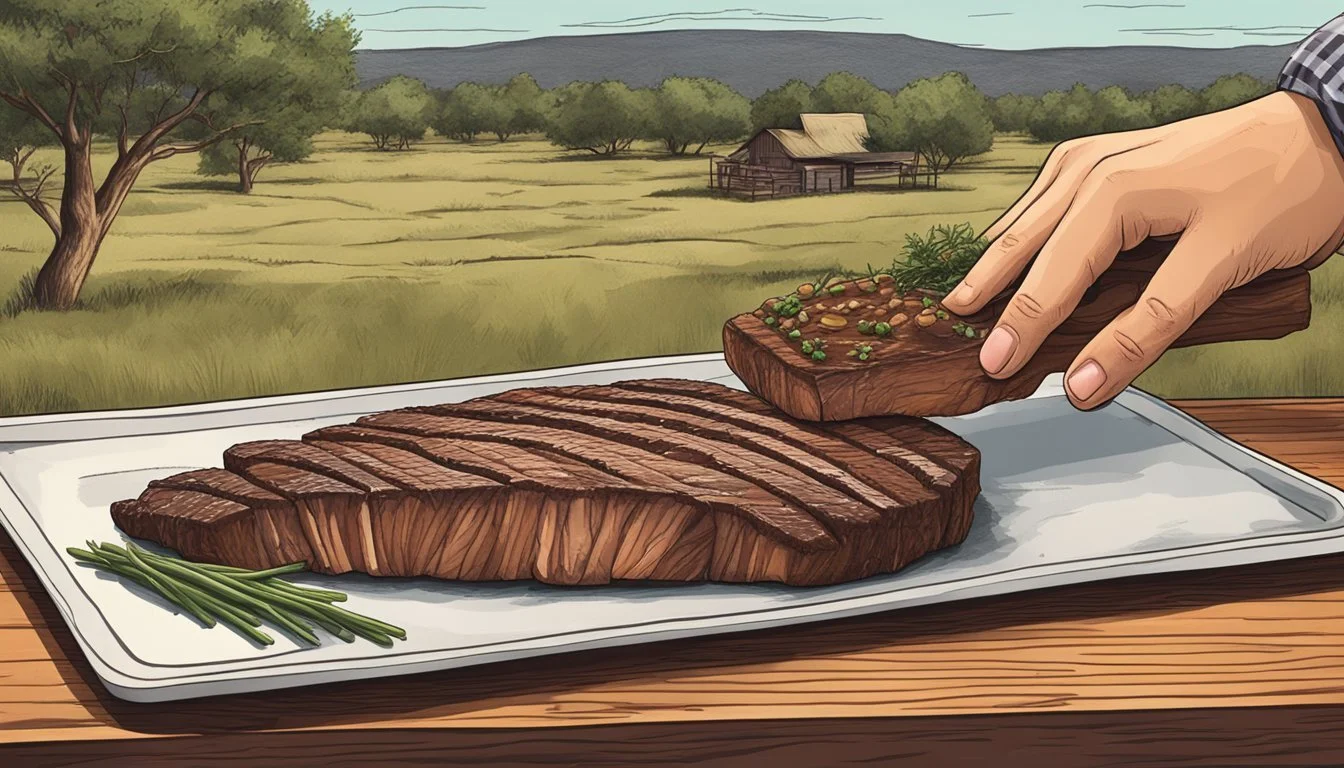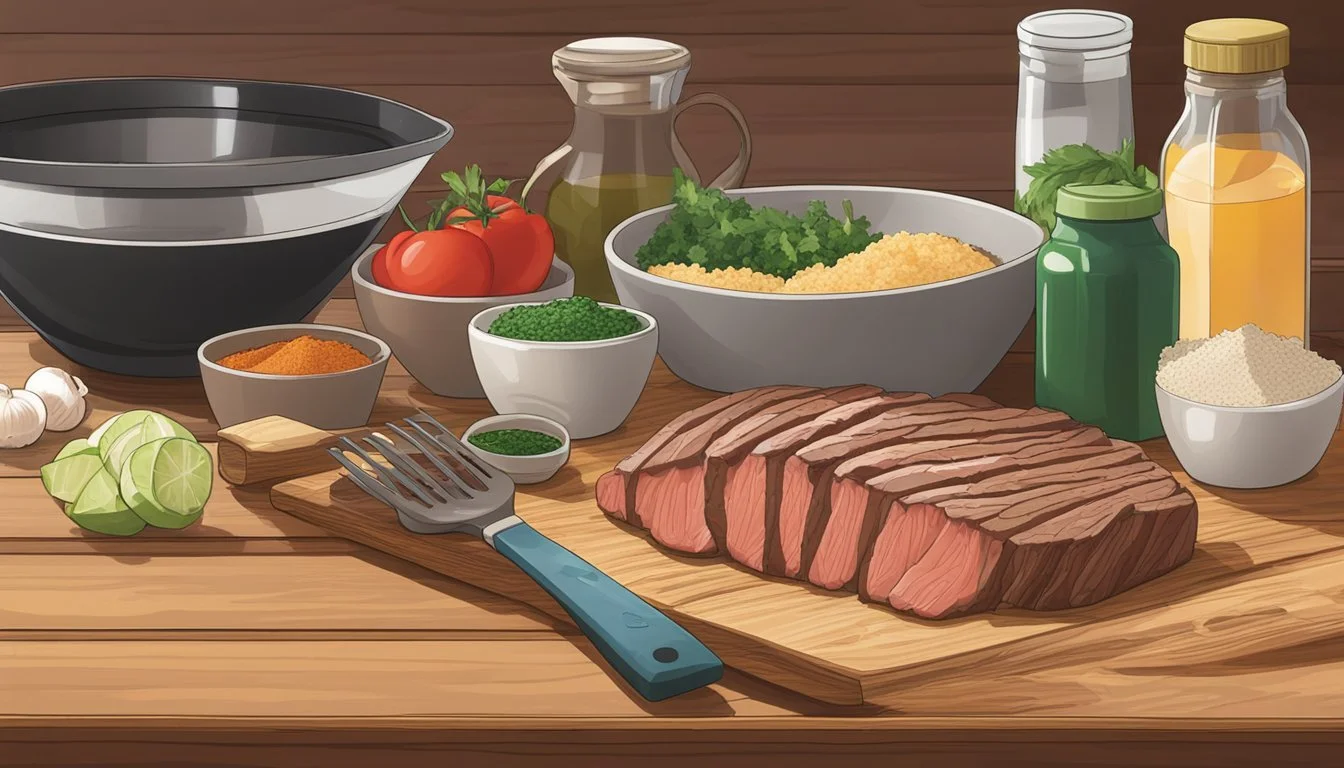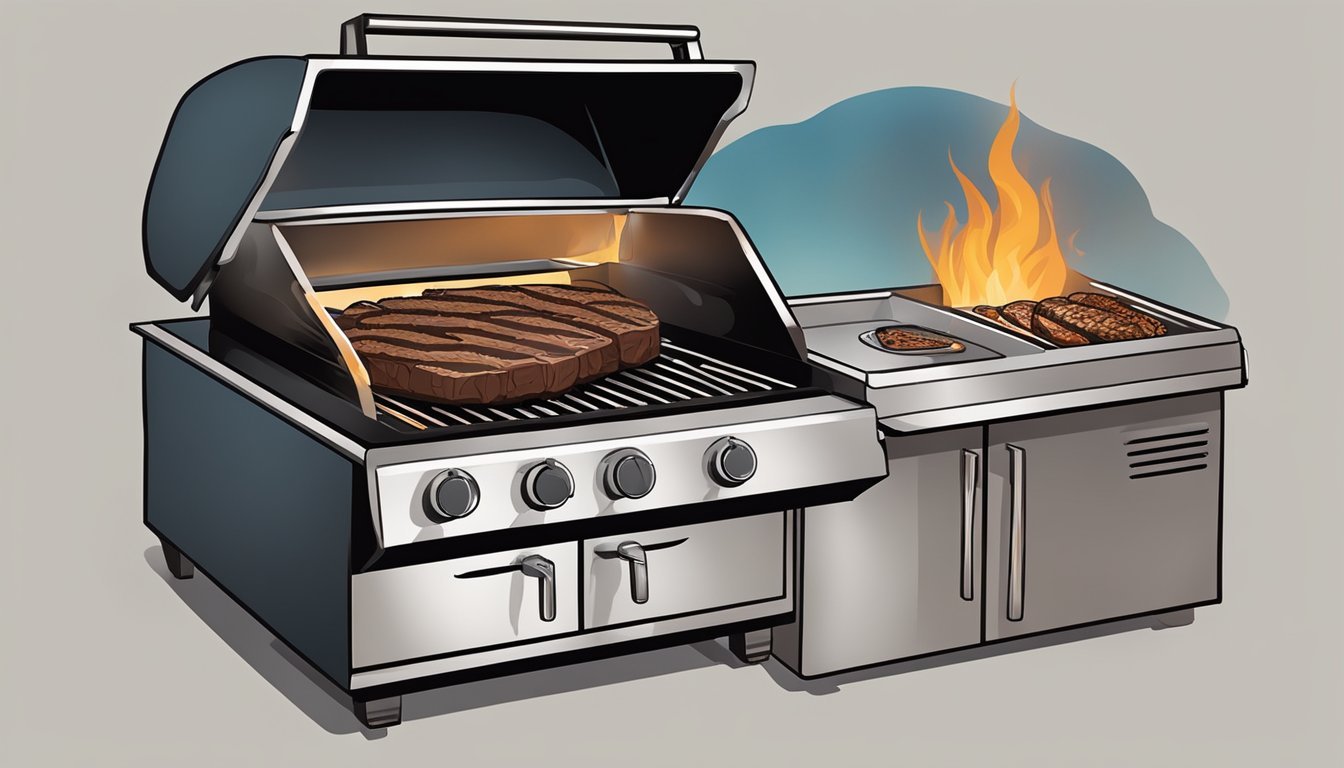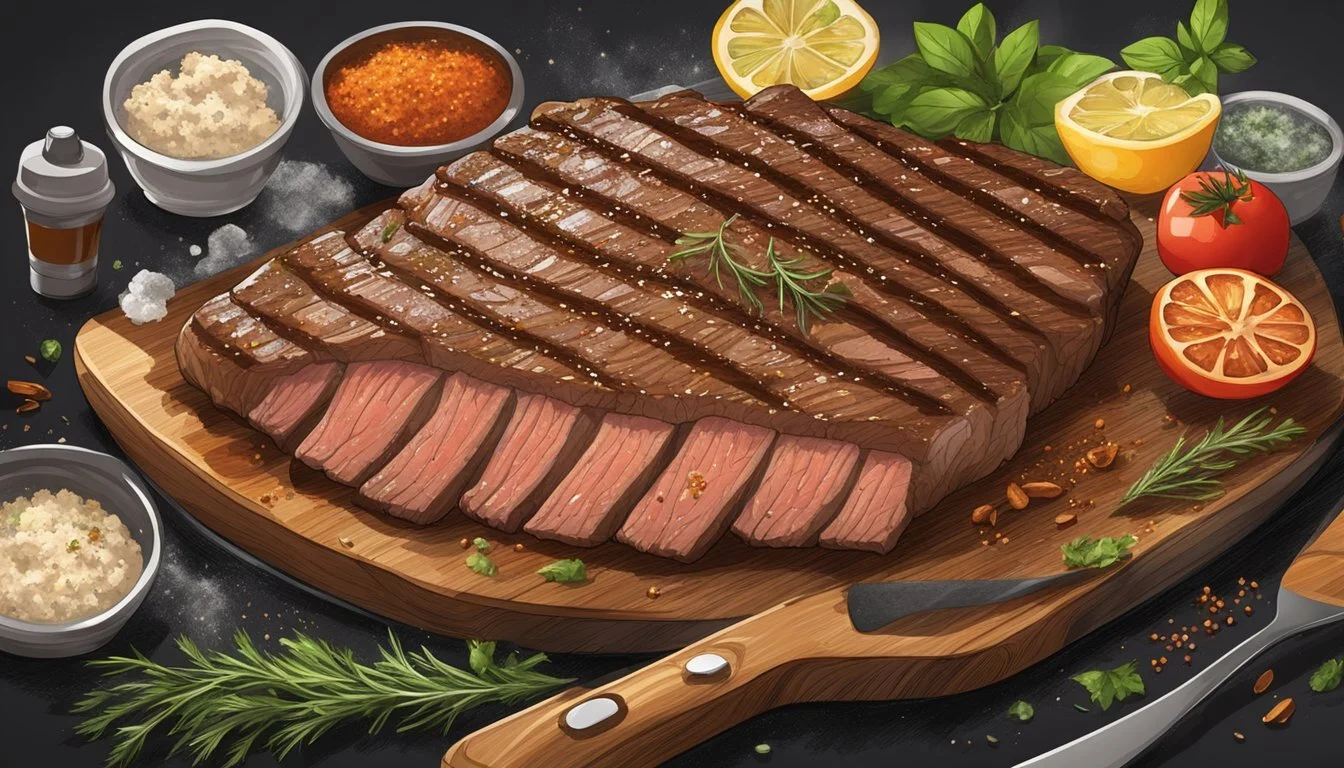How to Grill a Texas Style Flank Steak
Expert BBQ Techniques Revealed
Grilling a Texas-style flank steak presents a delightful opportunity to enjoy a tender, flavorful cut of beef that's versatile and relatively easy to prepare. Originating from the underbelly of the cow, flank steak is known for its strong beefy flavor and lean texture. When cooked properly, it yields succulent slices that are perfect for an array of dishes, from fajitas to salads. The key to a good Texas-style grill is to imbue the steak with robust flavors through marination and achieve the perfect char with attentive grilling.
A good recipe enhances the natural taste of the meat without overpowering it and involves a combination of seasoning and technique. Marinating the steak is a crucial step that infuses it with the classic flavors of the Lone Star State, typically incorporating ingredients like olive oil, Worcestershire sauce, and a hint of sweetness—be it from brown sugar or red wine vinegar. These flavors penetrate the meat, ensuring every bite carries the essence of Texas grilling. Grilling the flank steak to the right level of doneness, with a caramelized exterior and a juicy interior, requires a medium-high heat that perfectly sears the meat, sealing in the flavors and juices.
To achieve the desired result, the cook must monitor the heat and timing, understanding that a flank steak usually requires only a few minutes per side for optimal doneness. After grilling, it is customary to let the meat rest, allowing the juices to redistribute evenly. Then, the steak is typically sliced thinly against the grain for the most tender eating experience. The consistent application of these methods results in a cultured and authentic Texan culinary experience—the Texas-style grilled flank steak.
Selecting the Flank Steak
When grilling a Texas-style flank steak, the success of the dish hinges on selecting the right cut. Not all flank steaks are created equal, and understanding the nuances of this beef cut is crucial.
Identifying Quality Meat
A quality flank steak is essential for achieving the best flavor and tenderness. They should seek out meat that has a bright, cherry-red color, indicating freshness. The meat should also have a moist surface without any dry or slimy patches. Marbling, the white specks of fat within the beef, is less common in flank steaks because they are a leaner cut, but any small amount of marbling can contribute to flavor and juiciness. It is recommended to purchase beef that is either choice or prime grade, as these terms assure a high level of care in the meat's quality and handling.
Bright red color: Indicates freshness.
Moist surface: Avoid dry or slimy areas.
Minimal marbling: Look for any small amounts for improved taste and tenderness.
Beef grade: Opt for choice or prime.
Understanding Flank Steak Characteristics
Flank steak is a lean cut of beef that comes from the abdominal muscles of the cow. It is known for its strong muscle fibers and a grain that runs lengthwise. When selecting flank steak, one must inspect the thickness to ensure even cooking; the steak should be uniformly thick or be prepared to have varying levels of doneness. Given its lean nature, flank steak is best enjoyed when not overcooked, as it can become tough – the ideal doneness being medium-rare to medium. To maximize tenderness, the cook should plan to slice the steak against the grain post-grilling, shortening the muscle fibers and making it easier to chew.
Source: Abdominal muscles of the cow.
Muscle fibers: Long and strong throughout the cut.
Thickness: Look for uniformity or be mindful of varying doneness.
Doneness: Best at medium-rare to medium.
Slicing: Always cut against the grain for tenderness.
Preparing the Marinade
A properly prepared marinade is crucial for imbuing the Texas-style flank steak with robust flavor and tenderness. It consists of a balanced mix of oils, acids, salt, sugars, and seasonings to enhance the meat's natural taste.
Marinade Ingredients
Oils: 1/2 cup olive oil
Acids: 1/4 cup red wine vinegar, 1/4 cup lemon juice
Sugars: 2 tablespoons brown sugar
Salt: 1 tablespoon sea salt
Aromatics: 4 cloves minced garlic
Seasonings: 1 teaspoon black pepper, 2 tablespoons Worcestershire sauce, 1/4 cup soy sauce
Combining Flavors
The process begins with whisking together the olive oil and acids, ensuring the marinade has a sufficient base to tenderize and flavor the steak. To this, brown sugar and salt are added, both crucial for their respective roles in flavor enhancement and moisture retention within the beef. A robust garlic profile counterbalances the sweetness and contributes to the characteristic punch of the marinade.
The seasonings—cracked black pepper and Worcestershire sauce—are essential for a deeply savory and slightly tangy nuance. The soy sauce not only heightens umami but also serves as an additional tenderizing element due to its salt content.
For optimal fusion, chefs must ensure each ingredient is thoroughly combined before introducing the flank steak to the mixture. The steak should be immersed and coated in the marinade, then left to absorb the flavors for several hours, contributing to a more succulent result post-grilling.
Marinating the Steak
Proper marination is crucial for enhancing the flavor and tenderness of Texas-style flank steak. The marinade serves not only to impart bold flavors but also to tenderize the meat, making it more succulent.
Coverage and Soaking
To ensure the flank steak thoroughly absorbs the marinade, it should be submerged in the mixture. Ideal coverage involves the steak being evenly coated on all sides, which can be achieved in a zip-top bag. This method also has the advantage of being less messy and permits an easy way to flip and move the steak around within the marinade.
Steps for Coverage:
Place the steak in a zip-top bag.
Pour in the marinade, ensuring even distribution.
Expel as much air as possible before sealing to maximize contact between the meat and the marinade.
Periodically turn the steak in the bag to ensure every part spends time submerged.
Optimal Marinating Time
The optimal marinating time for a flank steak generally ranges between 2 hours to 24 hours. A longer marinating time allows the acids or enzymes in the marinade to work effectively to tenderize the meat. However, the steak should not marinate for more than 24 hours to avoid becoming mushy or overly saturated with the marinade flavors.
Recommended Marinating Times:
Minimum: 2 hours
Maximum: 24 hours
To achieve the best results, the steak should be placed in the refrigerator during the marinating process to maintain food safety and the integrity of the meat's texture.
Grill Setup
Setting up the grill correctly is a key step in achieving the best Texas Style Flank Steak. Whether using charcoal or gas, maintaining the right temperature and creating heat zones are crucial for optimal grilling.
Preparing Charcoal and Gas Grills
Charcoal Grill: To prepare a charcoal grill, one needs to:
Light the charcoal using a chimney starter or lighter fluid.
Wait for the coals to be covered with gray ash, indicating they're ready to use.
Arrange the coals to create heat zones. For a Texas Style Flank Steak, one will want a high heat zone and a cooler zone.
Gas Grill: Gas grills require different steps:
Ensure the gas tank is sufficiently full and all connections are secure.
Preheat the grill by turning the burners to high, closing the lid for about 10-15 minutes.
After preheating, adjust the burners to create a medium-high heat zone and a lower heat zone if necessary.
Grill Temperature and Zones
To grill a Texas Style Flank Steak, one must establish the appropriate temperatures:
Zone Temperature Purpose High Heat About 450°F to 500°F Searing the steak to lock in juices. Medium-High About 350°F to 400°F Cooking through to desired doneness.
Creating a High Heat Zone: This is for searing the steak and should be as hot as possible without causing flare-ups.
Establishing a Medium-High Zone: Adjust the grill for a medium-high zone if using charcoal. On a gas grill, this can be set by reducing the burner to medium-high after searing.
The grill grate should be clean and oiled to prevent sticking and ensure clean grill marks on the steak. One can use a grill pan if they prefer or if cooking indoors.
Grilling Techniques
When grilling Texas-style flank steak, achieving a perfect sear, managing flare-ups, and assessing doneness are pivotal for a delectable outcome. One should utilize a well-preheated grill and monitor the steak closely, utilizing tools like tongs and a reliable thermometer.
Searing the Steak
A hot grill is essential for a well-seared flank steak. Begin by preheating the grill to a high temperature, around 450-500°F. Oil the grates to prevent sticking, then place the steak on the grill. Sear the steak undisturbed for about 3-4 minutes on each side, ensuring you only flip it once to get that desirable crust.
Heat: High (450-500°F)
Time: 3-4 minutes per side
Flip: Once
Managing Grill Flare-ups
Grill flare-ups are common due to dripping fat, but they can be controlled. If flare-ups occur, use long-handled tongs to safely move the steak to another part of the grill. Keep the lid closed when not turning the steak, as this can starve the flare-ups of oxygen, reducing their intensity.
Tools: Long-handled tongs
Method: Move steak away from flare-ups
Testing for Doneness
Flank steak is best enjoyed when it's not overcooked. Use a meat thermometer to check for the preferred internal temperature of medium-rare, which should be around 130-135°F. Insert the thermometer into the thickest part of the steak to get an accurate reading.
Medium-Rare: 130-135°F
Tool: Meat thermometer
Doneness Internal Temperature Rare 120-125°F Medium-Rare 130-135°F Medium 140-145°F Medium-Well 150-155°F Well Done 160°F and above
Resting and Slicing the Steak
Proper resting and slicing are essential for a flavorful, tender Texas-style flank steak. These steps ensure the steak retains its juiciness and the slices are easy to chew.
The Importance of Resting Meat
Flank steak should rest after grilling to allow the juices to redistribute throughout the meat. Resting time depends on the steak's size, but typically, a flank steak should rest for 5 to 10 minutes before slicing. Resting helps to prevent the juices from running out onto the cutting board when slicing, which keeps the steak moist and tender.
Rare: 5 minutes rest
Medium-rare: Up to 10 minutes rest
During this time, the steak's internal temperature can rise slightly, finishing the cooking process. It's recommended to cover the steak with foil to keep it warm while it rests.
Cutting Against the Grain
Slicing steak against the grain is crucial for tenderness. Flank steak has long muscle fibers that can make it chewy when cut improperly. To identify the grain, observe the direction of the muscle fibers on the steak, and then slice perpendicular to those fibers.
Place the rested steak on a cutting board.
Position the knife at a 45-degree angle to the board.
Cut through the steak in smooth, even strokes, ensuring each slice is against the grain.
By cutting against the grain, the eater experiences a more tender bite, as the fibers are shorter and easier to chew. Even well-prepared flank steak can seem tough if sliced with the grain, making this step essential for the perfect grilled flank steak experience.
Serving and Accompaniments
When grilling a Texas-style flank steak, selecting the right side dishes and condiments enhances the meal's flavors and offers a balanced dining experience. Thoughtful pairings can turn the steak into the centerpiece of a memorable culinary event.
Side Dishes
Potatoes:
Hasselback potatoes provide a visually appealing and tasty side.
Steak fajitas pair well with seasoned or Mexican-style rice.
Vegetables:
Green beans, either steamed or bacon-wrapped, complement the heartiness of the steak.
A vegetable skewer with bell peppers, onions, and mushrooms offers a grilled side option.
Salads:
A simple wedge salad with blue cheese dressing balances the rich steak flavors.
Steak salad, incorporating thin slices of the grilled flank steak atop a bed of greens, makes for a lighter yet satisfying option.
Starches:
Flank steak tacos demand warm corn or flour tortillas as a staple side.
Mac and cheese or chilli oil noodles can add a comforting, indulgent touch.
Condiments and Sauces
Classic:
Freshly ground peppercorns bring out the beef's natural flavors while adding a spicy note.
Horseradish sauce delivers a pungent kick that stands up to the robustness of the steak.
Tex-Mex Inspired:
Pico de gallo offers a fresh, zesty accompaniment to steak fajitas or tacos.
Guacamole provides a creamy texture and rich taste that melds exceptionally well with the charred meat.
Barbecue:
A bold Texas-style barbecue sauce can be drizzled over the steak for an extra smoky flavor.
For something different, try a tangy chimichurri sauce, which gives a herby freshness to the dish.
Storing Leftovers
When it comes to storing leftover Texas-style flank steak, the key is to prevent moisture loss and avoid contamination. To maintain the steak's flavor and texture, proper storage methods and reheating techniques are imperative.
Proper Storage Techniques
Leftovers should be stored promptly to prevent bacterial growth. One should wrap the steak in freezer paper or aluminum foil, ensuring each piece is covered individually to minimize air exposure. The wrapped steak can then be placed inside a heavy-duty freezer bag. Here's how to optimize the storage:
Wrap: Individually wrap portions in freezer paper or foil.
Bag: Place wrapped steak in a single layer in a freezer bag.
Remove Air: Press out as much air as possible before sealing the bag.
TIP: For best results, store leftovers in the refrigerator if they will be consumed within three days. Otherwise, opt for the freezer to extend their shelf life.
Reheating for Best Quality
Reheating leftover steak properly can make a significant difference in maintaining its quality. The following steps ensure the steak remains as tender and flavorful as the freshly grilled version:
Thawing: If frozen, thaw leftovers in the refrigerator overnight.
Oven: Preheat the oven to 250 degrees Fahrenheit and place the steak on a wire rack over a baking sheet. This allows even heating.
Cover: Lightly cover the steak with foil to prevent it from drying out.
Reheat: Warm the steak until a meat thermometer reads 110 degrees Fahrenheit, ensuring it is just heated through and not overcooked.
Nutritional Information
Grilling a Texas-style flank steak offers a savory meal that's rich in proteins and nutrients. This section provides precise nutritional details to help diners make informed choices.
Calorie Count
When considering a 3-ounce (85 grams) serving of cooked Texas-style flank steak, diners can expect to consume approximately 160 to 180 calories. This lean cut of beef is known for being lower in calories compared to other cuts, making it a preferable option for calorie-conscious meals.
Health Benefits of Flank Steak
Flank steak is a lean cut of beef, which means it has a lower fat content. This attribute contributes to its lower calorie density while still providing ample protein. A 3-ounce serving typically offers about 23 grams of protein, which is essential for muscle repair and growth. Additionally, flank steak is a good source of various vitamins and minerals such as Vitamin B12, zinc, selenium, and iron. These nutrients play crucial roles in maintaining several bodily functions, including immunity and oxygen transport.
Recipe Variations and Ideas
Exploring variations to the classic grilled Texas-style flank steak allows for versatility in both flavor and preparation methods. Readers can adapt the recipe to suit different tastes and cooking equipment.
Alternative Cooking Methods
Cast-Iron Skillet: For those without a grill, a well-seasoned cast-iron skillet can provide a similar seared effect. Heat the skillet over high heat, add the steak, and cook for approximately the same time as one would grill.
Stir-Fry: Alternatively, the steak can be sliced thinly and used in a stir-fry. This requires cooking the slices quickly over high heat in a wok or skillet, providing a different texture and incorporation into varied dishes.
Flavor Variations
Marinade Recipe: The traditional marinade can be altered by adding ingredients like minced garlic, chipotle peppers, or a splash of bourbon to infuse distinct flavors.
Classic Texan: A mixture of Worcestershire sauce, garlic powder, and a hint of smoked paprika.
Spicy Twist: Introduce diced jalapeños or a teaspoon of cayenne pepper to the marinade for a heat kicker.
Herb Infusions: Incorporating fresh herbs such as thyme, rosemary, or cilantro can add aromatic qualities to the meat's crust.
Herb-Marinated: Mix chopped herbs into the marinade before applying to the steak.
Garnish: After grilling, finish the steak by sprinkling with finely chopped fresh herbs.
By incorporating these variations, one can personalize the grilled flank steak recipe to align with individual preferences or to experiment with new flavors and cooking methods.
Final Tips and Tricks
Achieving the perfect Texas-style grilled flank steak hinges on precise cooking and adapting to environmental factors. Here, essential techniques for using meat thermometers and grilling in differing seasons are detailed to ensure that each steak is grilled to perfection.
Meat Thermometer Usage
A meat thermometer is the grill master’s ally in hitting the ideal doneness. An instant-read thermometer should be used to monitor the internal temperature of flank steak. For a steak done rare, they should aim for an internal temperature of 120-130°F, while medium-rare will be at 130-135°F. Steaks should be removed from the grill 5°F before the target temperature as they will continue to cook slightly while resting.
Doneness Target Temp (Before Resting) Final Temp (After Resting) Rare 120-125°F 125-130°F Medium Rare 130-135°F 135-140°F Medium 140-145°F 145-150°F Well Done Over 160°F 160°F and above
Grilling in Different Seasons
The environment plays a crucial role in grilling. In the summer, when temperatures are high, the grill will reach the desired temperature faster and may retain heat better, which can lead to shorter cooking times. Grillers should be vigilant and may need to adjust timing accordingly. In contrast, in colder weather, it may take longer for the grill to preheat and the steak might require additional grilling time to reach the proper internal temperature. They must also protect the grill from wind, which can cool it down and cause an uneven cooking temperature.









